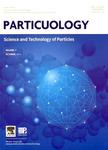Template-based growth of titanium dioxide nanorods by a particulate sol-electrophoretic deposition process
Template-based growth of titanium dioxide nanorods by a particulate sol-electrophoretic deposition process作者机构:Department of Materials Science & EngineeringSharif University of Technology Department of Materials Science & MetallurgyUniversity of Cambridge
出 版 物:《Particuology》 (颗粒学报(英文版))
年 卷 期:2011年第9卷第2期
页 面:161-169页
核心收录:
学科分类:081704[工学-应用化学] 08[工学] 0817[工学-化学工程与技术]
主 题:Nanorod Crystal morphology Electrophoretic deposition Sol electrophoresisTitanium dioxide
摘 要:TiO2 nanorods have been successfully grown into a track-etched polycarbonate (PC) membrane by a particulate sol-electrophoretic deposition from an aqueous medium. The prepared sols had a narrow particle size distribution around 17 nm and excellent stability against aging, with zeta potentials in the range of 47-50 mV at pH 2. It was found that TiO2 nanorods were grown from dilute aqueous sol with a low, 0.1-M concentration. Fourier transform infrared spectroscopy (FT-IR) analysis confirmed that a full conversion of titanium isopropoxide was obtained by hydrolysis, resulting in the formation of TiO2 particles. X-ray diffraction (XRD) results revealed that TiO2 nanorods dried at 100℃ were a mixture of anatase and brookite phases, whereas they were a mixture of anatase and futile structures at 500℃. Moreover, the rutile content of the TiO2 nanorods was higher than that of TiO2 powders. Transmission electron microscope (TEM) images confirmed that TiO2 nanorods had a smooth morphology and longi- tudinal uniformity in diameter. Field emission scanning electron microscope (FE-SEM) images showed that TiO2 nanorods grown by sol-electrophoresis from the dilute aqueous sol had a dense structure with a uniform diameter of 200 rim, containing small particles with an average size of 15 nm. Simultaneous differential thermal (SDT) analysis verified that individual TiO2 nanorods, grown into a PC template, were obtained after annealing at 500℃. Based on kinetic studies, it was found that uniform TiO2 nanorods with high-quality morphology were obtained under optimum conditions at an applied potential of 0.3 V/cm and a deposition time of 60 min.



